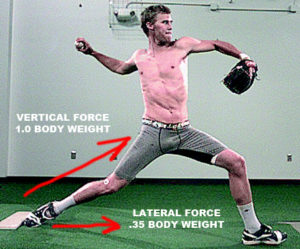 The entire power pitching delivery is a series of dynamic, action to reaction movements. High velocity pitchers generate more force production than low velocity pitchers, therefore, they also have more dynamic reactive movements. This is also why low velocity pitchers have a poor understanding of how and when these movements occur.
The entire power pitching delivery is a series of dynamic, action to reaction movements. High velocity pitchers generate more force production than low velocity pitchers, therefore, they also have more dynamic reactive movements. This is also why low velocity pitchers have a poor understanding of how and when these movements occur.
This article will help educate those low velocity pitchers on these reactive movements that are so critical to producing high pitching velocity.
Newton Teaches Pitchers Action to Reaction
You thought your Physics class was a waste of your time when your teacher was educating you on the work of Sir Isaac Newton. You more than likely had no idea your teacher was also giving you a lesson in pitching velocity. Newton's third law of motion defines these action to reaction movements in the pitching delivery.
Newton's third law of motion states:
For every action, there is an equal and opposite reaction
I am sure you have heard of this Newtonian law before or you actually remember the class you learned it in. If you are a low velocity pitcher working to learn the mechanics of the high velocity pitchers then this is a good place to start. This law proves that along with the elastic properties of the body, the body is capably of generating multiplying forces.The definition of Force multiplication is:
In military usage, refers to an attribute or a combination of attributes which make a given force more effective than that same force would be without it.
If you are going to learn how to generate these force multipliers in your body then you need to know how and when they must occur. Here is a list of these moments in the pitching delivery, along with the timing of them to support this force multiplication.
The 3 Force Multipliers of the Pitching Delivery
The 3 force multipliers in the pitching delivery include:
- Hip Rotation - This is when triple extension of the drive leg is pushing the back hip forward, as the front foot lands and the leg stabilizes, this force multiplied with the driving force of triple extension slams the hips open.
- Hip to Shoulder Separation - If the hips slam open just at or after front foot strike this pulls the back hip forward away from the back shoulder multiplying the force of the shoulder rotation.
- External Rotation - This is the point in the delivery when the shoulders have rotated open with forward trunk tilt causes the arm to externally rotation back behind the head multiplying the force of internal rotation and pitch release.
The Catch 22 of High Pitching Velocity
A Catch 22 as defined at Wikipedia:
Is a paradoxical situation in which an individual cannot avoid a problem because of contradictory constraints or rules.
In the case of pitching velocity, the catch 22 is that you must have the ability to generate enough power to create an explosive reactive movement to have an understanding of how it works to increase pitching velocity. This is why most pitching coaches can make a good living coaching the skill of pitching. It is a never ending battle for some pitchers who struggle with developing the power needed to generate optimal hip rotation into hip to shoulders separation and beyond. I like to call it beating your head against the wall. Most young pitchers experience this feeling too many times in their career. This is when they know what they need to do, but no matter how hard they try, they can not accomplish it. The answer I always give to these pitchers is, high velocity pitchers are made in the off-season. This is when you have the time to not only work on your power pitching mechanics but develop yourself into a power pitcher in a strength training program built around high intensity power movements like with the 3X Pitching Velocity program.



